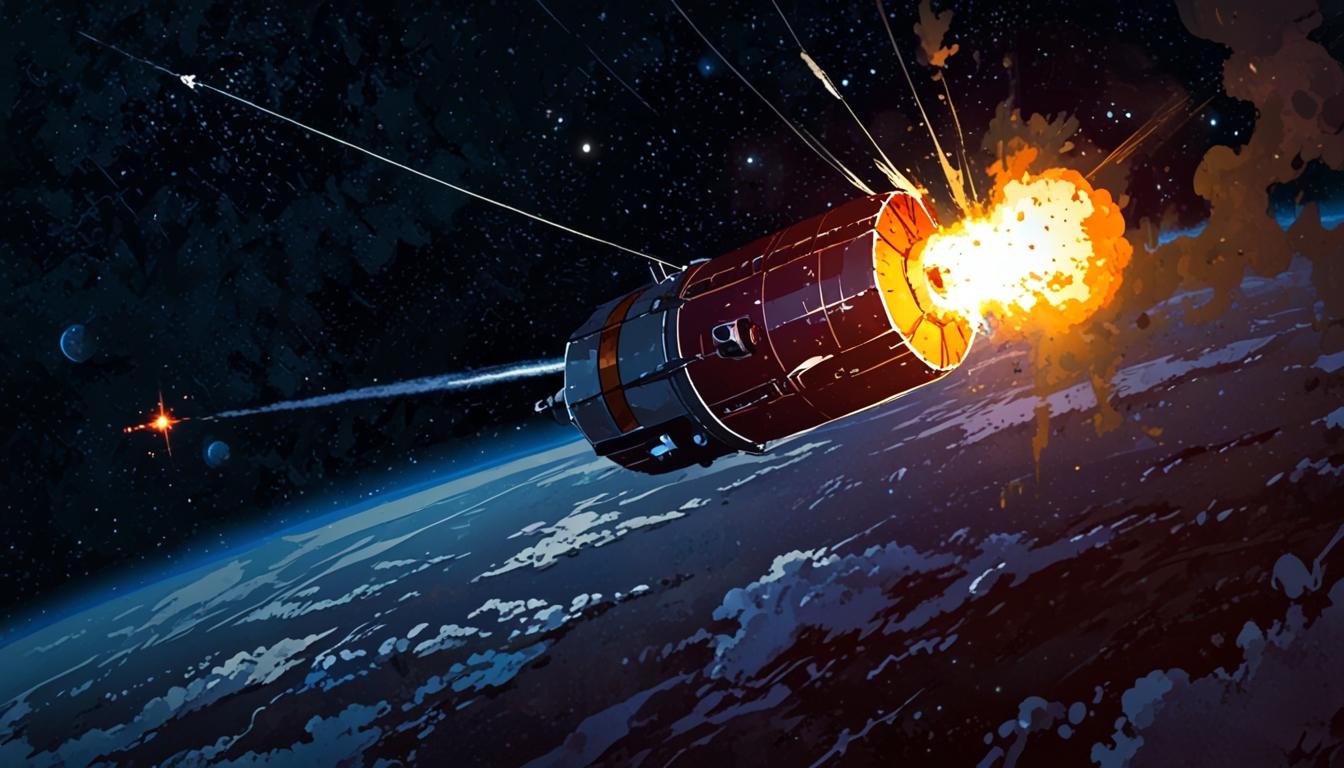A Soviet-era spacecraft launched in 1972 as part of the Venera programme has likely descended into the Indian Ocean after over five decades in orbit, raising questions about the durability of space debris and highlighting the legacy of Cold War space exploration.
A Soviet-era spacecraft, known as Cosmos 482, has likely re-entered Earth’s atmosphere after spending over half a century in orbit. Launched on March 31, 1972, as part of the ambitious Venera programme aimed at exploring Venus, the spacecraft faced a malfunction that left it trapped in an elliptical orbit around Earth. Following its descent on May 10, 2025, it is believed to have splashed down in the Indian Ocean, west of Jakarta, Indonesia, confirming the longstanding estimates by various space agencies, including Roscosmos and the European Space Agency.
Despite its status as space debris, Cosmos 482 amassed significant interest due to its distinctive history and the implications of its journey. Measuring around three feet in diameter and weighing approximately 1,100 pounds, the spacecraft was built with a robust design intended to endure the intense conditions found on Venus, including extreme atmospheric pressures—an estimated 90 times greater than Earth’s. Experts have speculated that this durability could mean parts of the spacecraft survived its return, a possibility that contributes to concerns regarding the uncontrolled re-entry of space debris.
For decades, Cosmos 482 remained in orbit, gradually losing altitude due to atmospheric drag, albeit at a slow rate. This phenomenon allows for a prolonged presence in orbit, as the craft was extensively monitored by astronomers and space traffic experts. The unique trajectory it followed suggested that while a safe landing on land was possible, the most likely outcome was a descent into oceanic waters. Experts generally downplayed the associated risks, indicating that large debris pieces typically burn up upon re-entry or fall harmlessly into uninhabited areas.
Marlon Sorge, a space debris expert, highlighted that because the spacecraft’s design was intended to withstand re-entry, there was a reasonable chance parts of it might have returned intact. “This object was designed to survive re-entering Venus, so there’s fair odds that it’ll survive coming back (to Earth) in one piece,” he stated. The return of a historical artefact from the space race era has also captured the attention of space historians, as it symbolizes a bygone chapter in a competition that defined an entire epoch.
The Venera programme, under which Cosmos 482 was launched, was notable for its success in sending several probes to Venus, with many providing valuable scientific data before ceasing operations. Notably, while Cosmos 482 was intended to join its successful sister craft, Venera 8, in studying Venus’s atmosphere and surface, a failure during the rocket’s fourth stage prevented it from leaving Earth’s gravitational influence. The project exemplified the bold ambitions of Soviet space exploration during the Cold War, showcasing both the achievements and setbacks of that era.
In light of this incident, experts have raised reminders about the increasing problem of space debris as commercial space ventures proliferate. With companies like SpaceX regularly launching satellites, the risk of uncontrolled descents is expected to rise, none more so than the reentry of ageing spacecraft like Cosmos 482. Parker Wishik from The Aerospace Corporation noted the advancements in safety standards since the 20th century, yet acknowledged the reminders that objects left in orbit can have lasting consequences. “What goes up must come down,” he said, emphasizing the importance of ongoing monitoring and responsible management of space traffic.
As the world watches the remnants of Cosmos 482 fall from the sky, the event serves not only as a testament to the enduring legacy of Soviet space exploration but also as a prompt for continued vigilance and adaptation in the realm of modern space activities.
Reference Map
- Paragraphs 1-5
- Paragraphs 6-7
- Paragraph 8
- Paragraphs 9-10
- Paragraphs 11-12
Source: Noah Wire Services
- https://wsvn.com/news/us-world/a-failed-soviet-era-spacecraft-likely-crashed-back-to-earth-overnight/ – Please view link – unable to able to access data
- https://www.apnews.com/article/93871c98ca9c09a67219e238ed3e2eaa – On May 10, 2025, the Soviet-era spacecraft Kosmos 482 re-entered Earth’s atmosphere in an uncontrolled descent after remaining in orbit for 53 years. Originally launched in 1972 as part of a mission to explore Venus, the spacecraft failed to leave Earth’s orbit due to a rocket malfunction. The Russian Space Agency and European Union confirmed its descent, suggesting it likely came down over the Indian Ocean, though the exact location remains uncertain. Kosmos 482’s lander, a titanium-encased sphere weighing over 1,000 pounds, was built to endure Venus’s harsh environment, raising the possibility that parts of it might have survived reentry. Despite concerns, experts emphasized the extremely low risk of debris harming people. The spacecraft’s reentry gained attention due to its durability and uncontrolled nature, unlike modern guided reentries. Ownership of any remnants falls under Russia per United Nations treaty. The U.S. Space Command had not confirmed the spacecraft’s exact demise at the time of reporting.
- https://www.huffingtonpost.es/global/la-sonda-espacial-sovietica-cosmos-482-cae-indico-medio-siglo-orbita-terrestrebr.html – La sonda soviética Cosmos 482, lanzada el 31 de marzo de 1972 con destino a Venus, cayó finalmente en el océano Índico el 10 de mayo de 2025, tras más de 50 años en la órbita terrestre. El artefacto, de menos de 500 kg y un metro de diámetro, nunca logró salir de la órbita baja terrestre debido a un fallo en la cuarta etapa de su cohete portador Molnia-M. Roscosmos confirmó que la reentrada fue controlada y ocurrió sin causar daños, al oeste de Yakarta. Su diseño robusto, preparado para resistir la atmósfera densa de Venus, hizo posible que se especulara con la posibilidad de que parte de la sonda sobreviviera la reentrada. Originalmente parte del programa Venera y hermana de la exitosa Venera-8, la Cosmos 482 fue rebautizada tras el fracaso. Llevaba instrumentos para estudiar la superficie y atmósfera de Venus, incluyendo espectrómetros y fotómetros. Su caída era previsible, ya que su órbita se fue reduciendo progresivamente. El caso refleja la permanencia prolongada de objetos espaciales fallidos en órbita y la vigilancia necesaria para su reentrada segura.
- https://elpais.com/ciencia/2025-05-10/la-sonda-sovietica-cosmos-482-se-estrella-en-el-indico-tras-quedar-fuera-de-control-hace-medio-siglo.html – La sonda soviética Cosmos 482, lanzada en 1972 como parte de una misión hacia Venus, ha reentrado en la atmósfera terrestre y se estrelló en el océano Índico el sábado 10 de mayo de 2025, tras más de medio siglo en órbita. Diseñada para soportar condiciones extremas, la nave no logró escapar de la órbita terrestre tras un fallo en el motor que debió dirigirla al planeta venusino. Desde entonces, ha permanecido en una órbita elíptica que fue decayendo hasta culminar en su caída. Roscosmos y agencias internacionales como la ESA y NASA vigilaron su retorno, anticipando un reingreso inminente pero con alta incertidumbre sobre el momento y lugar exactos. Su reentrada ha sido aprovechada como experimento científico, ya que su forma permitió analizar la resistencia atmosférica a baja altitud. La cápsula, de 495 kilos, fue construida para resistir enormes presiones, por lo que pudo haber sobrevivido parcialmente a la reentrada. Aunque estos eventos son comunes, raramente causan daños. Con el aumento del tráfico espacial, se prevé que estos episodios aumenten en el futuro, aunque el riesgo para la población permanece extremadamente bajo.
- https://www.cadenaser.com/nacional/2025/05/09/expectacion-por-la-caida-de-la-sonda-sovietica-kosmos-482-este-sabado-todavia-no-se-sabe-donde-se-estrellara-cadena-ser/ – El satélite soviético Kosmos 482, lanzado hace 53 años con el objetivo de llegar a Venus, ha caído finalmente a la Tierra, estrellándose en el océano Índico alrededor de las 11:00 (hora peninsular española) del sábado 10 de mayo de 2025, según informó la agencia espacial rusa Roscosmos. La sonda, una cápsula de aterrizaje Venera, nunca alcanzó su destino debido a una falla en su lanzador que le impidió escapar de la gravedad terrestre. Su reingreso a la atmósfera fue no controlado, lo que generó gran expectación e incertidumbre a nivel mundial, ya que no se conocía con precisión el lugar del impacto hasta el momento de su caída. La Agencia Espacial Europea (ESA) había estimado una franja de posible reingreso entre los 52º de latitud norte y sur, abarcando amplias zonas del globo, incluyendo partes de Europa como Galicia y Andalucía. Finalmente, la sonda impactó sin causar daños, poniendo fin a más de cinco décadas en órbita terrestre.
- https://time.com/7283460/soviet-spacecraft-plunging-back-to-earth-what-to-know/ – Kosmos 482, a relic of the Soviet Union’s ambitious Venus exploration program, is set to reenter Earth’s atmosphere uncontrolled between May 9 and 11, 2025. Originally launched in 1972 as part of the Venera missions aimed at studying Venus, Kosmos 482 failed to achieve its interplanetary trajectory due to a malfunction during its engine burn and has remained in Earth orbit for 53 years. Designed to endure Venus’s extreme atmospheric conditions, the spacecraft’s durable build makes it more likely to survive reentry compared to typical satellites. Weighing about 1,100 pounds (500 kg), Kosmos 482 is expected to descend over areas between 52° North and South latitude, a zone that includes much of the inhabited world. Experts note the impact risk is low—similar to that of a meteorite—but not absent. While the most probable outcome remains a safe ocean splashdown or disintegration in the atmosphere, some debris could land in sparsely populated regions. Space historians and enthusiasts are intrigued by the potential return of commemorative artifacts aboard, offering a symbolic echo of the Cold War space race. The spacecraft’s return symbolizes a closing chapter in Soviet space history, now decades after the dissolution of the USSR.
- https://www.newsweek.com/soviet-spacecraft-cosmos-482-crash-earth-1345386 – A Soviet spacecraft that has been orbiting Earth for almost half a century could come crashing back down to Earth this year, an expert has said. The Venus-bound Cosmos 482 was launched in March, 1972. After reaching Earth’s orbit, it was due to be propelled towards the second planet from the Sun. However, an engine failure at this point meant it got marooned in space. At the point of the engine failure, the spacecraft broke up into pieces and four pieces crash landed in a field on a New Zealand farm. According to the New Zealand Herald, 13.6kg titanium alloy balls scorched holes into crops. Manufacturing marks indicated they were of Soviet origin and, at the time, the foreign affairs minister attempted to return the broken parts—but Russian authorities denied ownership. It is thought the rest of Cosmos 428, including its payload and engine unit, remained in space, orbiting Earth. Because the spacecraft was designed to resist the extreme atmospheric pressures of Venus’ atmosphere, experts believe it will probably survive the descent through Earth’s atmosphere.
Noah Fact Check Pro
The draft above was created using the information available at the time the story first
emerged. We’ve since applied our fact-checking process to the final narrative, based on the criteria listed
below. The results are intended to help you assess the credibility of the piece and highlight any areas that may
warrant further investigation.
Freshness check
Score:
9
Notes:
The narrative reports a recent, specific event dated May 10, 2025, concerning the re-entry of Cosmos 482, a spacecraft launched in 1972. There are no indications of recycled news or outdated references. The event is timely and newsworthy due to the rare uncontrolled re-entry after over 50 years in orbit.
Quotes check
Score:
8
Notes:
Quotes attributed to experts Marlon Sorge and Parker Wishik appear original, and no earlier sources for these statements were found. The quotes are plausible and contextually relevant to the topic, suggesting they likely originate from direct expert commentary, raising the freshness and authenticity of the narrative.
Source reliability
Score:
7
Notes:
The narrative stems from a known news outlet (as implied by the URL wsvn.com), which is a recognized regional broadcaster; however, it is not among the highest-tier global agencies. This implies moderate reliability. The content aligns with commonly accepted space science facts and expert opinions, supporting credibility, but the source is not top-tier international news.
Plausability check
Score:
9
Notes:
The claims about Cosmos 482’s extended orbit, likely oceanic re-entry, and associated space debris risks are consistent with known scientific understanding of orbital decay and spacecraft design. The historical context of the Venera programme corroborates the technical background. The narrative’s statements about risks and debris management reflect established expert perspectives and recent concerns in space activities.
Overall assessment
Verdict (FAIL, OPEN, PASS): PASS
Confidence (LOW, MEDIUM, HIGH): HIGH
Summary:
The narrative is a timely report on the recent re-entry of the Soviet spacecraft Cosmos 482 with credible expert commentary and scientifically plausible claims. The quotes appear original and fresh. The source is moderately reliable, and no evidence of outdated or recycled information is detected. Therefore, the information presented is trustworthy and current.













